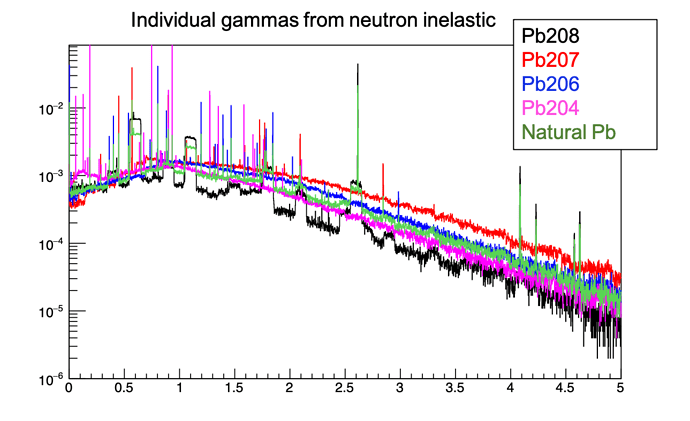Hello,
I am interested in simulating natural lead activation with 14 MeV neutrons. The specific reactions I care about are Pb207(n,n’)Pb207m and Pb208(n,2n)Pb207m. The Pb207m undergoes Isomeric Transition with 0.806 sec half-life time constant, emitting two gammas with energies 569.698 keV and 1063.656 keV.
The output I want to model is those delayed gamma, i.e., I want to correctly model the gammas’ emission time and energy. But I have not been able to get that from Geant4 yet.
To study this, I set the lead volume to have only one isotope type at a time, and this is what I’ve found so far:
1-Gamma emission energy: individual gammas emitted from neutron inelastic processes seem to follow the decay scheme for most isotopes. I think these are mostly (n,n’) reactions.
However, for Pb208, the individually emitted gammas form “boxes” in the spectrum around the decay scheme gamma lines. See the attached plot. These would include the Pb208(n,2n) reaction gammas. When summing the total energy from all neutron inelastic processes in the event, the Pb208 spectrum boxes are “washed out” into rolling bumps.
My question: Is there a reason to expect that the inelastic gammas emitted from Pb207(n,n’)Pb207m to be modeled more accurately than those from Pb208(n,2n)Pb207m, even though they have the same final excited state.
Note: It does not seem that Geant4 is actually modeling Pb207m as the final state.
2-Gamma emission time: the Pb207m isomeric transition to the ground state has a 0.806 sec half-life time constant. However, Geant4 is not producing delayed gammas with that time signature.
My question: is the isomeric transition time signature modeled in Geant4? If so, how is that turned on?
Thanks!
!

